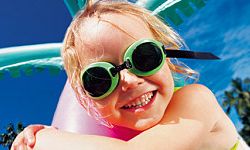For some people, it's a rite of spring: the first plunge into the backyard pool, opening day at the local water park. Others splash year-round in indoor pools or tropically warm outdoors. Either way, swimming is a favorite way to stay in shape, the third most popular type of exercise in the United States [source: National Sporting Goods Association]. Swimming is especially good exercise for children. It works all of the major muscle groups and improves cardiovascular health. Unlike many other sports, it doesn't stress the bones and joints in ways that could damage still-developing skeletal systems, particularly in overweight children.
Yet, even for youngsters who take to the water like sea otters, drowning and injury are real threats that can turn a fun-filled outing into a frightening, even fatal ordeal. Drowning is the second-leading cause of injury-related death in children aged 1 to 14 [source: Kansas Journal of Medicine]. Those under age 5 are especially vulnerable, with a death rate twice that of older children [source: Safe Kids USA]. About 300 toddlers and preschoolers drown in pools and spas every year, and another 3,000 are hospitalized with swimming-related injuries [source: Consumer Product Safety Commission].
Advertisement
For survivors and their families, the outlook can be grim. Caring for a near-drowning survivor who suffers brain damage can cost up to $180,000 a year [source: Kansas Journal of Medicine]. Of course, the price paid in grief and emotional trauma can't be counted.
Other unseen danger lurks in the form of disease-causing viruses and bacteria in the pool water, often carried by the swimmers themselves. These microbes can result in irritation and infection of the eyes, ears, lungs and digestive tract. Outdoor pools also carry added risk: The combination of standing water, bare skin and food at pool parties lures mosquitoes and some types of bees. Their bites and stings can make you miserable. If they spread encephalitis or cause allergic reactions, they can kill.
These facts should give you pause. However, while accidents will happen, they don't have to happen to you. You can create a safe environment through "layers of protection," a favorite term of safety experts. That includes a hazard-free setting, proper equipment and safety-savvy kids. In this article, we break down each of those components, starting with another old saying: "An ounce of prevention is worth a pound of cure."
Advertisement



